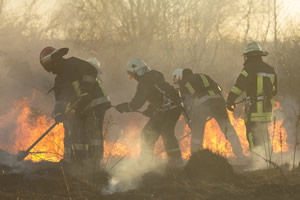Wildfires Go to College
- By Michael Fickes
- 04/01/19

PHOTO © STOCKPHOTOSLV
Is your college or university campus located in an area near forests or open lands where a forest or wildfire might break out? If so, have you added procedures related to wildfires to your emergency operations plan? How will you protect your students, faculty, visitors, and administrators should a wildfire break out near your campus? Worse, what if a wildfire strikes your campus?
Of course, a number of the precautions taken to protect students in the event of a largescale fire are the same as you would employ to prepare for and, if necessary, escape severe weather, floods, active shooters, and other life-threatening emergencies.
It Takes a Village
For instance, one key precaution is to get to know the first responders that cover your area: firefighters, police, and other emergency responders. Visit these folks and invite them to visit and inspect your campus. When they arrive, show them around, go over the steps you plan to take should a forest fire or other large fire break out somewhere in the surrounding area. Ask for their help and advice with your emergency planning.
Do you know when and how a fire might threaten your campus?
“In addition to fire safety, you should have a protocol or plan to prevent people on your campus from suffering smoke inhalation, a major concern with large-scale forest fires near populated areas,” says Michael Dorn, executive director of Juliette, GA-based Safe Havens International, Inc., a nonprofit organization that promotes campus safety and crisis preparedness.
Smoke from large-scale fires can travel great distances, depending on the strength and direction of winds active in the area.
If smoke but not fire is coming toward your location, you might urge those with access to cars and other vehicles to take off for an unaffected area and wait out the situation. For those that have no transportation and cannot leave, impose a curfew and require everyone on campus to stay inside until the smoke threat has passed.
“Most schools in the U.S. face risks of hazardous materials events including building and structural fires, chemical releases, and other atmospheric releases that may be dangerous,” Dorn says. “When protecting your campus for a shelter-in-place event, remember to shut down systems that bring air into buildings.” These might include systems pulling air through kitchen exhaust systems as well as air conditioning systems.
Then again, if the authorities warn that a dangerous fire is on its way, you must evacuate—as early and as fast as possible.
Transportation Concerns
How will you transport those that need rides? K–12 schools facing fires can draw on school buses. “If you need to move a lot of people, you will need access buses,” says Joyce Lopes, vice president for administration and finance at Sonoma State University in Rohnert Park, CA.
Where will the buses come from? Area K–12 school buses will, of course, be occupied moving their own school students and teachers.
What other transportation services might you be able to tap? There may be tour bus companies near you. A daily bus service may operate in your town or city. Is there a local train service? Visit these companies and talk to them about getting their help moving students in an emergency.
Questions you must answer before a crisis erupts: What steps will you need to take to gain access to transportation in an emergency requiring evacuation? How quickly can you gain access to transportation? Where will you direct the buses to take students and faculty?
More questions: What if you will need to stay overnight—a likely prospect. What kind of sleeping arrangements will be available? You’ll need to feed everyone, too. Is there a way to store food at your destination? If not, you may need to store emergency food at your location and move it with the students and faculty when you leave the campus.
Lopes’ fire-safety plan was tested in a 2017 fire. The plan worked successfully. No one was hurt.
“The fire started on a Sunday,” she says. “The emergency manager on our campus received a call at 2:30 a.m., and we immediately set up an emergency operations center—which followed guidelines set by California’s Standardized Emergency Management System, known as SEMS.”
Emergency Management
SEMS was developed by California’s emergency planners, who used the federal National Incident Management system (NIMS) as a model.
According to the California Governor’s Office of Emergency Services, SEMS forms the basis of the state’s emergency management system. SEMS incorporates four key services:
- Incident command system (ICS)— This is a field-level emergency response system.
- Multi/inter-agency coordination— Affected agencies working together to coordinate allocations of resources and emergency response activities.
- Mutual aid—A system for obtaining additional emergency resources from non-affected jurisdictions.
- Operational area concept—County and its subdivisions to coordinate damage information, resource requests, and emergency response.
“Each section has been trained to manage its particular area,” says Lopes. “The system was set up to run emergency operations for 10 days—which is a very long time for an Emergency Operations Center.”
The steps that Lopes took reflects the widespread concern about and activity pursuing fire safety among fire services all across the country.
Dorn adds that a solid wildfire safety protocol includes the protocol for hazardous materials sheltering. “There are clouds of smoke coming during such a fire,” he says. “If the area hasn’t been cleared, no one should be outside. Everyone should shelter in place. Normally, there will be a command center capable of communications across the area.”
In the end, Dorn emphasizes that it is important to include fire-safety in your college’s emergency operation plan. Of course, fire-safety planning should cover fire inside the school and fire in buildings around the school. And if you are located in a rural area with forests, then the plan should certainly address forest fires.
This article originally appeared in the College Planning & Management April/May 2019 issue of Spaces4Learning.